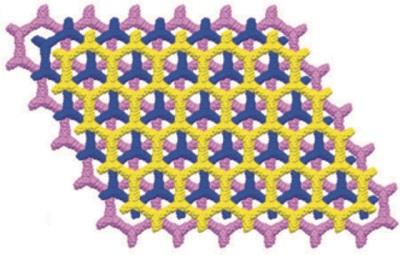A step to understanding polymorphs

This is an overhead view of the hexagonal sheets, shifted in respect to each other. Credit: Zentner et al
This study lies at the very heart of understanding and being able to control properties of molecular structures. Pharma and agrichem industries attach great importance to understanding crystal structure.
The solid form impinges directly on properties such as solubility, bioavailability, processing characteristics, bulk density, dissolution rate, permeability, surface electrostatic charge and so on, so it is imperative to have a clear understanding of the molecular-level make-up of a material and how this affects its properties.
This study illustrates that the high Z' phenomenon, like polymorphism itself, has many root causes but careful study of each structure allows the identification of organization principles in most cases.
Brock leaves the door open for future research saying “very few structures are so complex that it is difficult to understand how the crystals could have formed”.
This comprehensive survey, in conjunction with a groundswell of work by a number of groups on this increasingly intriguing problem over the past 20 years, shows that there is no one-size-fits-all explanation and that the details of each structure are uniquely tied to the chemical details of the molecules that comprise it. The search goes on, but perhaps we are now at least beginning to know how to formulate the question.
Media Contact
All latest news from the category: Life Sciences and Chemistry
Articles and reports from the Life Sciences and chemistry area deal with applied and basic research into modern biology, chemistry and human medicine.
Valuable information can be found on a range of life sciences fields including bacteriology, biochemistry, bionics, bioinformatics, biophysics, biotechnology, genetics, geobotany, human biology, marine biology, microbiology, molecular biology, cellular biology, zoology, bioinorganic chemistry, microchemistry and environmental chemistry.
Newest articles

Trotting robots reveal emergence of animal gait transitions
A four-legged robot trained with machine learning by EPFL researchers has learned to avoid falls by spontaneously switching between walking, trotting, and pronking – a milestone for roboticists as well…

Innovation promises to prevent power pole-top fires
Engineers in Australia have found a new way to make power-pole insulators resistant to fire and electrical sparking, promising to prevent dangerous pole-top fires and reduce blackouts. Pole-top fires pose…

Possible alternative to antibiotics produced by bacteria
Antibacterial substance from staphylococci discovered with new mechanism of action against natural competitors. Many bacteria produce substances to gain an advantage over competitors in their highly competitive natural environment. Researchers…





















